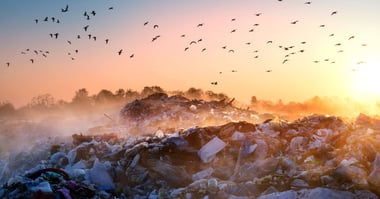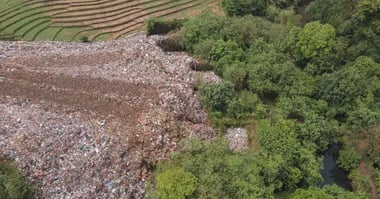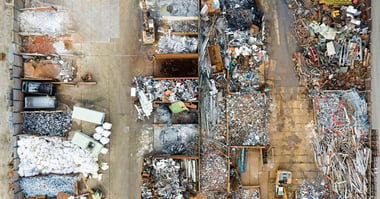
Zoë Lenkiewicz
Guest post: Zoë Lenkiewicz, Waste and Sustainable Development Goals Expert for the United Nations Environment Programme
“Please throw your rubbish in the river” said the sign on Bangka Island on the northeastern tip of Sulawesi, at the heart of the Coral Triangle.
A global centre of marine biodiversity, the Coral Triangle is a 6 million km2 area spanning Indonesia, Malaysia, the Philippines, Papua New Guinea, Timor Leste, and the Solomon Islands. This nursery of seas hosts 76% of the world’s coral species, six of the world’s seven marine turtle species, and at least 2,228 reef fish species. It also supports the livelihoods of some 120 million people.
But how plastic is affecting precious ecosystems in the Coral Triangle? Let's take a look.
.jpg?width=2400&height=1260&name=Diving%20with%20plastic%20(1).jpg)
What's on this page?
01 | Plastic in the Coral Triangle02 | Waste management on small island communities
03 | Preventing marine plastic pollution
04 | Case study: Cleaning up Bangka Island
05 | Summary: The solutions
Plastic in the Coral Triangle
Waste management in Coral Triangle countries has failed to keep up with population growth, economic growth, and the exponential growth of waste.
With waste management options being to dump or to burn, most coastal communities in the area are leaking waste into the ocean, giving the Coral Triangle the undesirable moniker of the Trash Triangle.
A study in 2015 found that 55% of fish in Indonesian markets had plastic in their guts — a figure that has since undoubtedly worsened.
According to UNEP’s Small Island Developing States (SIDS) Waste Management Outlook, over 80% of mismanaged waste in SIDS ends up in the ocean, leading to biodiversity loss, decreased revenue from tourism, and health impacts from pollution exposure.
Waste management in small island communities
Plastic pollution from land and marine-based sources poses risks to entire marine ecosystems, coral reefs and mangrove forests, shellfish and fish stocks, and aquaculture.
Through the process of ‘rafting’, pathogens, microorganisms, seaweeds and invertebrates can be dispersed long distances on floating litter, resulting in the spread of disease and the invasion of alien species in coastal and marine habitats.
The annual economic cost of marine plastic pollution, including its impacts on fisheries, aquaculture and tourism as well as the cost of clean-ups, is estimated to be at least $6-19 billion globally. This figure does not, however, account for impacts on human health or marine ecosystems.
Here are the nine key things you should know about when it comes to waste management in small island communities:
- Land is at a premium — and there is little capacity for safe waste disposal.
- It's often prohibitively expensive to send waste to the mainland by sea.
- Residents have agreed sites for waste dumping, where leachate permeates the ground, contaminating drinking water, spreading disease and stunting crop growth.
- Rivers can provide a free waste disposal service for villagers, but the waste washes back to their own shore – or someone else’s.
- Rising sea levels erode informal dumpsites, spilling previously contained waste into the sea.
- Beach litter picks can feel like Groundhog Day, with plastics washing ashore on a seemingly endless tide.
- Open burning of waste is commonplace, filling the air with smoke that harms health and contributes to climate change, which in turn accelerates sea level rise.
- Local economies are often dependent on tourism, but tourists are deterred by litter strewn across beaches and tangled in coral reefs.
- Fishing communities suffer from boat motors becoming blocked with plastic, while fish stocks are becoming depleted due to the effects of plastic pollution.
.jpg?width=2400&height=1260&name=Plastic%20in%20corals%20(1).jpg)
Preventing marine plastic pollution
Preventing pollution from waste is a matter of environmental, social and economic justice.
Sustainable Development Goal 14 includes the target to “Prevent and significantly reduce marine pollution of all kinds, in particular, from land-based activities and plastic debris”. However, stemming the tide of plastic pollution in the oceans is a multidimensional challenge that spans many of the Global Goals.
During the first two sessions of the Intergovernmental Negotiating Committee to develop an internationally legally binding instrument on plastic pollution, many interventions from national governments have referred to:
- The urgency of tackling plastic pollution
- The need to go beyond voluntary measures
- The right to a healthy environment, the gender perspective, and a human rights approach
- The protection of human health and the environment with a focus on vulnerable groups
- Specific principles of international law (e.g. common but differentiated responsibilities and respective capabilities, equity, precautionary principle, polluter pays principle)
- Establishing Extended Producer Responsibility (EPR) schemes and addressing hazardous plastics
- The importance of ambitious means of implementation, including the establishment of a dedicated multilateral fund
- The need to have a member-state-driven process
- The importance of National Action Plans as an implementation measure
Case study: Cleaning up Bangka Island
Plastic use has grown exponentially in part because it is very cheap to produce. Consequently, by the time it becomes waste, it is practically valueless.
Rather than being paid for their time and service to society, waste collectors are often paid piecemeal according to the market value of the materials they collect (and even then, at the lower end of the market value since aggregators and reprocessors also take their cut).
Collecting waste often involves working in unpleasant conditions, with no shelter from the sun and with the risk of injury, disease and harassment.
Yet a range of case studies from the global south suggest that waste pickers typically earn around 10 cents per kg of plastic. To put this in perspective, 1kg is the equivalent of 100 PET bottles.
For low-value and non-recyclable plastics, including lightweight flexible packaging such as sachets and bags, the market value is essentially zero. As a consequence, there is no direct financial incentive to collect this material, and without intervention, it is simply left as litter.
Working at a local diving resort on Bangka Island, Anna Clerici of the No Trash Triangle Initiative felt compelled to address the plastic pollution washing ashore every day, affecting the fragile coral reefs and in turn the local economy.
“We arranged for resorts to deliver plastic waste to a central point, and then ferried it all across to the mainland,” said Anna. However, transporting waste by sea is expensive and without financial support, the scheme would not have been sustainable. “Through some valuable partnerships, the No Trash Triangle Initiative has now built a plastic sorting centre on the island and we are running the island’s only waste management service.”
How CleanHub helps the mission
The service is funded in part through a partnership with CleanHub, which pays for the recovery of the low-value, non-recyclable plastics that wash ashore every day, including flip-flops, broken chairs, fishing nets and the ubiquitous sachets.
Recovery data is tracked and traced with an online dashboard for transparency, while dignity and living standards for people working along the waste streams, especially the lowest paid, are a central focus of the programme.
Brands support CleanHub’s partnerships through Corporate Social Responsibility (CSR) programmes, enabling the collection of non-recyclable plastic waste while ensuring staff involved in the collecting and sorting of plastic waste are paid a fair wage and have decent working conditions.
“We get to know the local team and explore their motivations” explained Rizal Ratulangi, from the Impact team of CleanHub. “We want to work with other people who are passionate about creating dignified conditions, safety standards – if there is promise, and a commitment to improve, we form a partnership to help fund the recovery of materials that would otherwise remain in the environment.”
.jpg?width=2400&height=1260&name=CleanHub%20%26%20NTTI%20(1).jpg)
Summary: The solutions
The forthcoming Plastics Treaty is raising people’s hopes about bringing an end to the era of plastic pollution, and in particular its impact on the world’s oceans.
It will surely take a combination of both upstream (limiting plastic production and designing out waste) and downstream measures (collecting and safely managing unavoidable waste) to make the impact that’s needed.
Extended Producer Responsibility schemes that charge producers for the cost of waste management are only as strong as enforcement allows. In countries with large informal economies, including unregistered and unregulated plastic producers and importers as well as a large informal sector of waste collectors, achieving full participation will be an immense challenge.
In the meantime, voluntary Corporate Social Responsibility initiatives are often the best hope that many remote communities have to protect fragile ecosystems – and human health – from the worst effects of unmanaged waste and plastic pollution.
While voluntary initiatives alone will not be anywhere enough, this type of programme offers the opportunity for brands to make a significant positive impact, and importantly to know that waste collectors have safe, decent and dignified working conditions and are receiving a fair, regular and reliable wage.
Environmental impact and social change go hand-in-hand. Bangka Island may be just a tiny dot on the map, but what’s happened here offers a pathway for other island communities to follow.

.webp)


.webp?width=380&name=River%20waste%20(1).webp)

%20(1).webp?width=380&name=Plastic-on-the-beach%20(2)%20(1).webp)
%20(1).webp?width=380&name=Pile-of-plastic%20(1)%20(1).webp)

.webp?width=380&name=solar-collection%20(1).webp)
.jpg?width=380&name=Microplastics%20in%20hands%20(1).jpg)
.webp?width=380&name=Plastic-pollution-surface-of-water%20(1).webp)

